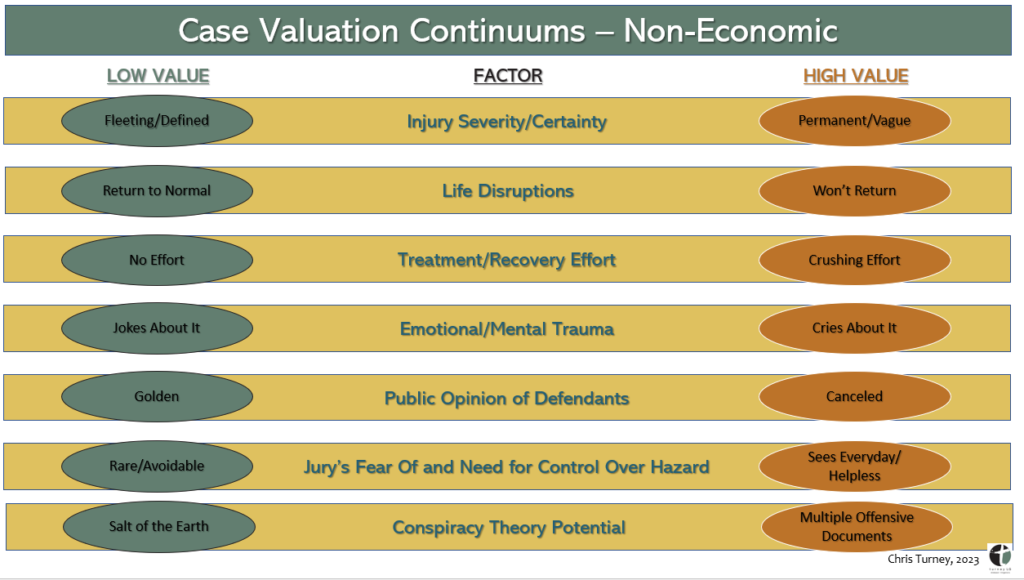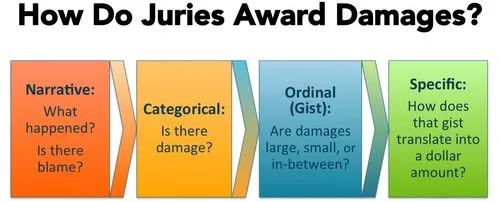By Dr. Ken Broda-Bahm:

Most of those who work in civil litigation are now familiar with the “anchoring effect,” and know that suggesting a number has an influence when it comes to damages. But attorneys may not know just how powerful that effect is. Research has repeatedly demonstrated that, independent of the evidence, asking for more in trial raises the chance of getting more on the verdict form. And the “more” in the ask doesn’t always have a solid connection to the evidence. In a classic study on the effect of anchors, researchers (Tversky & Kahneman, 1974) demonstrated that even a random spin of a numerical wheel prior to making an unrelated estimate (e.g., the number of countries on the African continent) shows that higher spins result in higher guesses. In other words, even when we know the anchor is arbitrary, it can still have a powerful influence.
Plaintiffs have lately been taking advantage of that. In a recent decision (Gregory v. Chohan, 2023 Tex. LEXIS 528) the Texas Supreme Court reversed a case due to the plaintiffs’ attorney suggesting numbers such as the $71 million dollar cost of an F-18 aircraft or the $186 million dollar price tag of an abstract painting by Mark Rothko. Ultimately, the jury awarded $16.5 million in damages, with 90 percent of that being noneconomic, based on counsel’s suggestion of awarding 2 cents for each of the 650 million miles driven by the defendant’s trucks during the year of a traffic accident. The verdict was reversed and remanded based on the appellants’ argument that these numbers lacked any rational connection to the evidence. In a recent article for DRI, “Noneconomic Damages – Anchoring a Verdict Without Angering the Court,” Eric Passeggio of Sulloway & Hollis and Chris Turney, of Turney LG take a very useful look at what the case says to attorneys about how to rationally anchor their noneconomic damages. While the court was clear in holding that “unsubstantiated anchoring” is prohibited, it was less clear on what works to substantiate damages in less quantifiable categories. Under the heading “So, How Do We Talk About Noneconomic Damages?” Passeggio and Turney answer, “It is not completely clear” since the court demands a rational connection to the evidence without giving examples or guidelines of what that rational connection might be. This leaves us with a logical question, relevant to both sides, of how to anchor. Extending on the analysis of Passeggio and Turney, I would like to use this post to add my own two cents to the good advice given
The Problem in Grounding Noneconomic Damages
In addition to the legal reason for preferring grounded numbers, there is also a reason that comes from social science: Numbers with a meaningful basis are more effective in anchoring the jury (Reyna et al., 2015). Within economic damages categories, that grounding is a matter of showing receipts and estimates, but in the noneconomic categories like loss of capacity or pain and suffering, that can be much trickier.
Sharing that “Gregory notably lacks guidance as to proper evidence and argument of noneconomic damages,” Passeggio and Turney observe that, “It is not clear what evidence is sufficient to sustain a verdict for noneconomic damages or the limits of argument by counsel for plaintiffs or defendants.” That poses a practical challenge for advocates seeking to ground their anchor. The authors note that defendants should strive to find counter-anchors that come with an articulable reason that the number connects to the evidence.
To that end, they share this chart that defendants should use to assess the degree of noneconomic harm:

Applying these categories to one’s own case is a useful exercise for analyzing where jurors might be motivated by higher or lower numbers. The first four categories are probably the most legally relevant to most noneconomic categories, with the last three being more likely to be background factors for jurors that could motivate jurors’ numbers, but not necessarily for legally correct reasons.
Mapping these categories against your own case is a good step, but it still does not get you to grounded numbers that the Gregory decision calls for. For example, the plaintiff might face a life disruption that is severe, and won’t return to normal, but articulating that still does not put you in the realm of quantification, which is what anchoring requires.
To continue this discussion, I want to take a step back, and add some context from social science.
Toward a Solution: Adapting to Jurors’ Ways of Getting from Narratives to Numbers
I have written before about the recent line of research showing that there actually is some method to the madness of jurors’ arrival at damages numbers. A line of studies (Reyna et al., 2015) led by Valerie Reyna and Valerie Hans of Cornell shows that jurors regularly follow a sequence of decisions like this:

The damages portion is referred to as the “two-stage” model referring to the last two steps, of jurors deciding on the “gist” of the damages (is the loss at issue big, typical, or small?) before mapping that ordinal decision onto more specific numbers. In light of the Gregory case, the tricky trapeze act is getting from this ordinal gist to the specific number. Broken down that way, all of the factors in the chart from Passeggio and Turney speak to the “gist” of the damages, but not to the numerical nexus.
Arguably, by using seemingly arbitrary numbers, plaintiffs could be read as addressing that step of getting from a gist to a number: If the damages in this case ought to be “big,” then what in this age of social inflation counts as “big?” Cue the cost of an F-18 or a Rothko painting.
It is understandable though that courts, and certainly defendants, don’t see that as a fully rational or supportable basis. Obviously both sides need to continue to work toward finding that basis. I believe the research on this two-stage model, including an exploration of the ways jurors bridge that gap, should continue, and we are still in just the first few years of this research project. But based on my own observations of how I see jurors do this in jury research, I see several routes:
Relating the Numbers
Most commonly, jurors will see the more subjective categories in relation to the more concrete categories, applying some sense of a proportion: e.g., the pain and suffering is at least as high as the medical expenses, or half as high, or twice as high.
Chunking the Numbers:
Where allowed, counsel or jurors will divide a longer span (e.g., the rest of the plaintiff’s life) into shorter chunks (years, weeks, hours) and then try to put a value on that smaller chunk before multiplying. Where allowed, which is in roughly half the states, this step doesn’t necessarily make the decision more logical, but it does tend to make jurors more comfortable by making the decision seem more manageable. Interestingly, this approach also seems to help a plaintiff’s liability case.
Analogizing the Numbers.
Analogies can be figurative or literal, and judicial constraints like those exercised in the Gregory decision tend to say that it is the figurative analogies that are forbidden: the emotional toll of a loss isn’t really like an F-18 jet. But what if we are comparing to something that really does have a logical connection? For example, the cost of a college education is now about $150,000 to buy a better quality of life. If the plaintiff’s loss compares, even abstractly, to the kind of value that might come from an education (or half, or twice as much), then a figure like that could serve as an anchor.
Projecting the Numbers.
This last idea might be more creative, and hence frowned upon by courts like the Texas Supreme Court, but I have seen mock juries bring it up: What amount of money would you take in order to take the plaintiff’s condition on? For example, consider that an unethical medical researcher is bargaining with you to see what the price would be for giving you this condition for the rest of your life. For many cases, that number is likely to be more plaintiff-friendly.
Not all of these arguments would be allowed in front of all judges, but parties should continue to think of ways to substantiate their noneconomic anchor. Think carefully about it, and potentially study the effects of different anchors and foundations. Ultimately, it is not an easy communication task, and it often gets to a point that many jurors and mock jurors will get to: “How can you put a number on that?” Defendants can play to that uncertainty, and jurors’ doubt and discomfort can arguably act as its own anchor.
The question of how to recommend a number that is reasonable and grounded remains an elusive but important one. The issues ought to be fully assessed and tested in the unique context of every case.
______________________
Other Posts on Counter-Anchors:
- Counter the Plaintiff’s Damages Anchor (Especially When It’s Overboard)
- Damages Defense: Carefully Set the Smaller Anchor
- Defense Damages Counter-Anchor: Get Them to Calculate, Not Speculate
______________________
Reyna, V. F., Hans, V. P., Corbin, J. C., Yeh, R., Lin, K., & Royer, C. (2015). The Gist of Juries: Testing a Model of Damage Award Decision Making. Psychology, Public Policy, and Law, Psynet, posted: Jun 22 , 2015
Passeggio, E. & Turney, C. (2023, October 9). Noneconomic Damages – Anchoring a Verdict Without Angering the Court. DRI, Syndicated by JDSupra: https://www.jdsupra.com/legalnews/anchoring-a-verdict-without-angering-3114377/
Tversky, A., & Kahneman, D. (1974). Judgment under Uncertainty: Heuristics and Biases: Biases in judgments reveal some heuristics of thinking under uncertainty. science, 185(4157), 1124-1131.